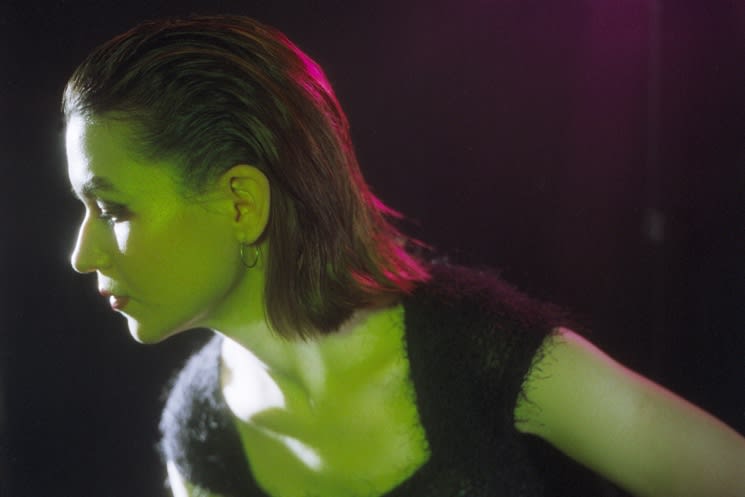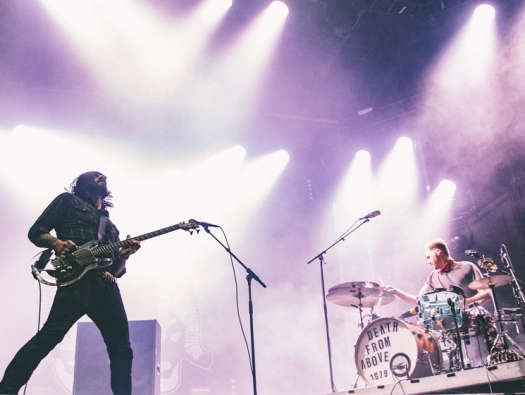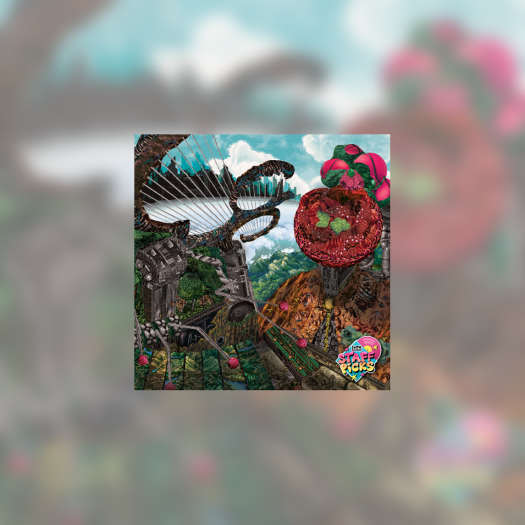Have you ever wondered what the planets sound like? Toronto producer Stefana Fratila has, and she went on a five-year mission to find out.
Back in 2017, Fratila was looking to represent the planets of our solar system with plug-ins: software within a digital audio workstation that can be used to add instruments or effects to a song. Plug-ins like virtual synths, compressors and equalizers can be crucial for musicians trying to create a particular atmosphere — but, unfortunately for Fratila, the planetary plug-ins she was looking for didn't exist.
At this point, most people would accept that their new track simply isn't going to sound like Saturn — but Fratila isn't most people. What followed was a quest to both find audio data on the celestial bodies in our solar system, and to actually make plug-ins for each one. (Except Pluto, sadly, whom we all miss and love as a former member of our solar system's planetary roster.)
After acquiring a Canada Council for the Arts grant for the project, Fratila began contacting people at NASA. Once she found the right scientists, they got her approved to visit Goddard Space Flight Center in Greenbelt, MD, and NASA's Jet Propulsion Laboratory in Greenbelt, MD. As these are essentially military bases, this was no small feat, but it allowed Fratila to access data and conduct interviews for her project.
Aside from gaining valuable knowledge about atmospheric science, Fratila learned that NASA scientists were curious about the same things as she was. They too wanted sound from space, but it was in short supply, and for a very practical reason: weight. Audio equipment adds heft to spacecraft desperately trying to stay light. Video gives more valuable information, so it's prioritized. That all changed mid-project, however: "In 2020, they sent up the Mars Rover [Perseverance]," Fratila tells Exclaim! "I knew that was happening when I started this project, so myself and all the scientists I had been working with were very excited. This would be the first time that actual microphones would be sent to a planet's surface. It was unprecedented."
So, Mars is in the bag, and obviously we have audio of Earth, but the rest of the planets are trickier. We're not sending audio equipment to the remaining planets anytime soon, which is where creativity comes in. This whole project lies at an interesting crossroads of the artistic and scientific mind. Fratila had tons of data to work with, but at the end of the day, she didn't have raw audio. So, the plug-ins for the rest of the planets would need to come from imagination — albeit imagination based heavily in data and research.
"I felt like I could take quite a bit of creative liberty because I was coming at it as an artist, not as a scientist," says Fratila. "I was really interested in having these plug-ins reflect my interpretation. I've never claimed that these are factual or anything. I don't think that's really the point of the project. Any scientist will tell you that everything can be disputed. We might be completely wrong about certain aspects of these plug-ins, but this is based on the information we have currently."
The eight open-source VST plug-ins themselves, titled Sononaut, each have four faders (Dry, Atmosphere, Pitch and Weather) that can be moved around to create different effects. The Mercury plug-in, however, just has Dry, Weather and Ear to Ground, because the planet doesn't have an atmosphere. "With Mercury, I had to think of a creative way to do that plug-in," Fratila explains. "Instead of having an Atmosphere fader, I thought it would be interesting to imagine how vibrations would travel through the human body. So I had the idea that you could only hear if you put your ear to Mercury's surface. Obviously, you can't actually do that because you'd die, but that's the beauty of this project. It got me thinking about how sound would work on all these planets."
Another thing that Fratila garnered from her research, with some mathematical help from Dr. Conor Nixon, are the planets' "keys." If you take Earth to be middle C (261.63 Hz) and input Mars's data, based on gas components and atmospheric density, the pitch becomes 173 Hz. So, the human voice, for example, would be pitched down to that lower frequency while on Mars. In turn, a planet like Saturn, whose pitch is 579 Hz, has a ring of ice and rock particles that potentially collide with each other on a regular basis, so that aspect was incorporated into the weather loop on its plug-in.
All of this data and more — the research details surface pressure, mean molecular weight, speed sound, and a host of other factors — will be available when the plug-ins are made public.
Additionally, Fratila has recorded the album I want to leave this Earth behind (comprised of 8 tracks, of course, due out April 21 via Halocline Trance) using the plug-ins, with some additional melodies from her trusted Moog Subharmonicon and OP-1 synthesizers. The album itself is an ambient spacewalk through the solar system, rife with crunchy textures and simulated weather wafting about your ears. She has even written some short stories about her imagined experiences on these planets, which will be available in the vinyl gatefold of the album's physical release.
While it might seem like Fratila has her head in the stars, she's also doing work here on Earth that's very much grounded. Together with Renee Dumaresque, Fratila founded CRIP RAVE™, an event night that centres on the needs of "disabled, deaf, mad and sick communities." They want to make raves accessible, but their ideas around accessibility go much further than just being able to enter a venue; CRIP RAVE™ puts disabled people's safety, comfort and talents at the forefront of the events.
"We want the rave space to still be for people who love raves, but we want those spaces to be more accessible," Fratila says. "There's a lot of things that can come in there, including harm reduction supplies, for example. It can also be as simple as just making sure you have staff to help people navigate the space, having alcohol-free options at the bar, hydration stations, varied seating options. So many raves don't have seats at all."
They've put on a number of shows so far, both in-person and virtual, with more planned for the coming year, in their own time — "crip time," as Fratila calls it. Organizing these parties has now evolved into consulting work, where Fratila and Dumaresque speak with promoters about meeting the various needs of their patrons.
"I'm excited about the idea of collaborating with different organizing bodies or festivals," says Fratila. "That's something that really motivates us, because if we work on an event with someone, they're better equipped to enact some of these access techniques in the future. So, it's a fluid way of learning. We can learn more as we see how everybody does things differently, and they learn what it means to put on a truly accessible event."
Considering the many facets of Stefana Fratila's out-of-this-world artistry, our initial label of "Toronto producer" now seems wholly inadequate. She's a promoter, consultant, accessibility advocate, sound designer, writer, musician — and at this point, it's fair to add scientific researcher to the list.
Back in 2017, Fratila was looking to represent the planets of our solar system with plug-ins: software within a digital audio workstation that can be used to add instruments or effects to a song. Plug-ins like virtual synths, compressors and equalizers can be crucial for musicians trying to create a particular atmosphere — but, unfortunately for Fratila, the planetary plug-ins she was looking for didn't exist.
At this point, most people would accept that their new track simply isn't going to sound like Saturn — but Fratila isn't most people. What followed was a quest to both find audio data on the celestial bodies in our solar system, and to actually make plug-ins for each one. (Except Pluto, sadly, whom we all miss and love as a former member of our solar system's planetary roster.)
After acquiring a Canada Council for the Arts grant for the project, Fratila began contacting people at NASA. Once she found the right scientists, they got her approved to visit Goddard Space Flight Center in Greenbelt, MD, and NASA's Jet Propulsion Laboratory in Greenbelt, MD. As these are essentially military bases, this was no small feat, but it allowed Fratila to access data and conduct interviews for her project.
Aside from gaining valuable knowledge about atmospheric science, Fratila learned that NASA scientists were curious about the same things as she was. They too wanted sound from space, but it was in short supply, and for a very practical reason: weight. Audio equipment adds heft to spacecraft desperately trying to stay light. Video gives more valuable information, so it's prioritized. That all changed mid-project, however: "In 2020, they sent up the Mars Rover [Perseverance]," Fratila tells Exclaim! "I knew that was happening when I started this project, so myself and all the scientists I had been working with were very excited. This would be the first time that actual microphones would be sent to a planet's surface. It was unprecedented."
So, Mars is in the bag, and obviously we have audio of Earth, but the rest of the planets are trickier. We're not sending audio equipment to the remaining planets anytime soon, which is where creativity comes in. This whole project lies at an interesting crossroads of the artistic and scientific mind. Fratila had tons of data to work with, but at the end of the day, she didn't have raw audio. So, the plug-ins for the rest of the planets would need to come from imagination — albeit imagination based heavily in data and research.
"I felt like I could take quite a bit of creative liberty because I was coming at it as an artist, not as a scientist," says Fratila. "I was really interested in having these plug-ins reflect my interpretation. I've never claimed that these are factual or anything. I don't think that's really the point of the project. Any scientist will tell you that everything can be disputed. We might be completely wrong about certain aspects of these plug-ins, but this is based on the information we have currently."
The eight open-source VST plug-ins themselves, titled Sononaut, each have four faders (Dry, Atmosphere, Pitch and Weather) that can be moved around to create different effects. The Mercury plug-in, however, just has Dry, Weather and Ear to Ground, because the planet doesn't have an atmosphere. "With Mercury, I had to think of a creative way to do that plug-in," Fratila explains. "Instead of having an Atmosphere fader, I thought it would be interesting to imagine how vibrations would travel through the human body. So I had the idea that you could only hear if you put your ear to Mercury's surface. Obviously, you can't actually do that because you'd die, but that's the beauty of this project. It got me thinking about how sound would work on all these planets."
Another thing that Fratila garnered from her research, with some mathematical help from Dr. Conor Nixon, are the planets' "keys." If you take Earth to be middle C (261.63 Hz) and input Mars's data, based on gas components and atmospheric density, the pitch becomes 173 Hz. So, the human voice, for example, would be pitched down to that lower frequency while on Mars. In turn, a planet like Saturn, whose pitch is 579 Hz, has a ring of ice and rock particles that potentially collide with each other on a regular basis, so that aspect was incorporated into the weather loop on its plug-in.
All of this data and more — the research details surface pressure, mean molecular weight, speed sound, and a host of other factors — will be available when the plug-ins are made public.
Additionally, Fratila has recorded the album I want to leave this Earth behind (comprised of 8 tracks, of course, due out April 21 via Halocline Trance) using the plug-ins, with some additional melodies from her trusted Moog Subharmonicon and OP-1 synthesizers. The album itself is an ambient spacewalk through the solar system, rife with crunchy textures and simulated weather wafting about your ears. She has even written some short stories about her imagined experiences on these planets, which will be available in the vinyl gatefold of the album's physical release.
While it might seem like Fratila has her head in the stars, she's also doing work here on Earth that's very much grounded. Together with Renee Dumaresque, Fratila founded CRIP RAVE™, an event night that centres on the needs of "disabled, deaf, mad and sick communities." They want to make raves accessible, but their ideas around accessibility go much further than just being able to enter a venue; CRIP RAVE™ puts disabled people's safety, comfort and talents at the forefront of the events.
"We want the rave space to still be for people who love raves, but we want those spaces to be more accessible," Fratila says. "There's a lot of things that can come in there, including harm reduction supplies, for example. It can also be as simple as just making sure you have staff to help people navigate the space, having alcohol-free options at the bar, hydration stations, varied seating options. So many raves don't have seats at all."
They've put on a number of shows so far, both in-person and virtual, with more planned for the coming year, in their own time — "crip time," as Fratila calls it. Organizing these parties has now evolved into consulting work, where Fratila and Dumaresque speak with promoters about meeting the various needs of their patrons.
"I'm excited about the idea of collaborating with different organizing bodies or festivals," says Fratila. "That's something that really motivates us, because if we work on an event with someone, they're better equipped to enact some of these access techniques in the future. So, it's a fluid way of learning. We can learn more as we see how everybody does things differently, and they learn what it means to put on a truly accessible event."
Considering the many facets of Stefana Fratila's out-of-this-world artistry, our initial label of "Toronto producer" now seems wholly inadequate. She's a promoter, consultant, accessibility advocate, sound designer, writer, musician — and at this point, it's fair to add scientific researcher to the list.




